No-Knead Oatmeal Toasting Bread
This post may contain affiliate links. Please read my disclosure policy.
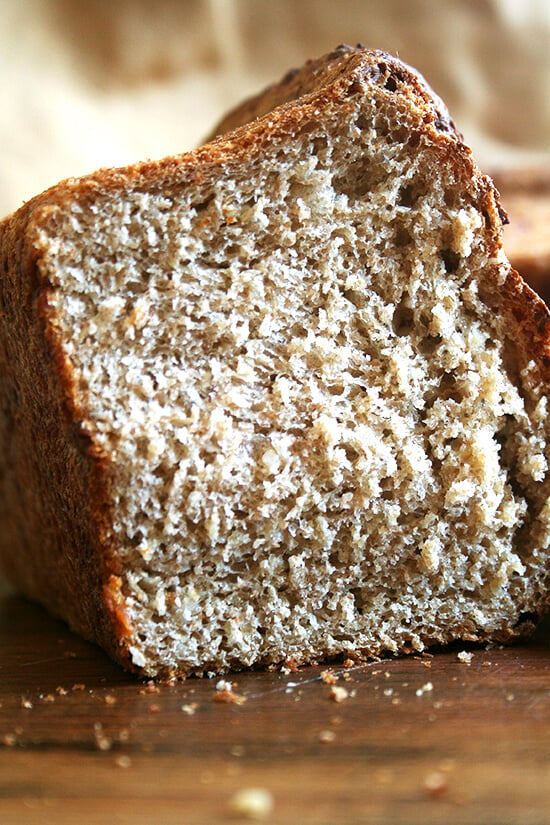
Before heading to the beach last week for a little vacation with the family, I spent some time in the kitchen preparing a few items to pack along: granola, granola bars (which, unfortunately, were inedible) and this no-knead oatmeal toasting bread, a tried-and-true family favorite.
The goal was meal supplementation — to avoid eating every meal out — and in retrospect, I wish I’d prepared more, namely biscotti, which were sorely missed, and something chocolaty to satisfy our post-dinner sweet tooths — midweek we caved and stocked up on chocolate-almond Hershey bars from the local convenience store … never have they tasted so good.
But this bread was a savior. We ate it every morning toasted and slathered with peanut butter and nearly every afternoon, at times with lettuce, tomato and bacon wedged in between, at others with nutella and peanut butter, and at others with a thick layer of melted cheese and sliced tomato.
It is a cinch to prepare — true to the title, no kneading is involved — and the bread, chewy in texture and slightly sweet, is just straight-up delicious, a treat to have on hand on vacation or not.
My only goal tomorrow is to restock my freezer with another two loaves, and thanks to the 100ºF forecast, I’m almost certain to achieve it. Perhaps insufferable heat isn’t all that bad? Just trying to stay positive. Hope you’re all staying cool.
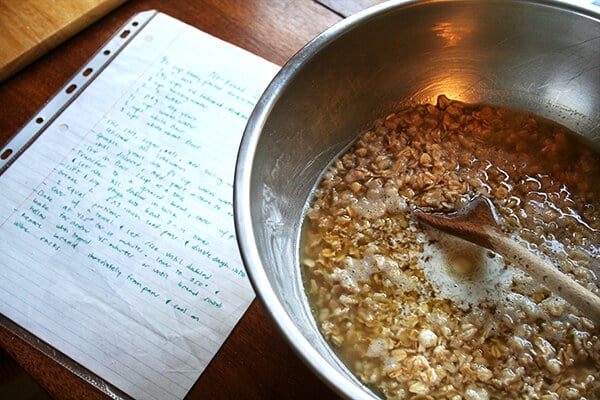
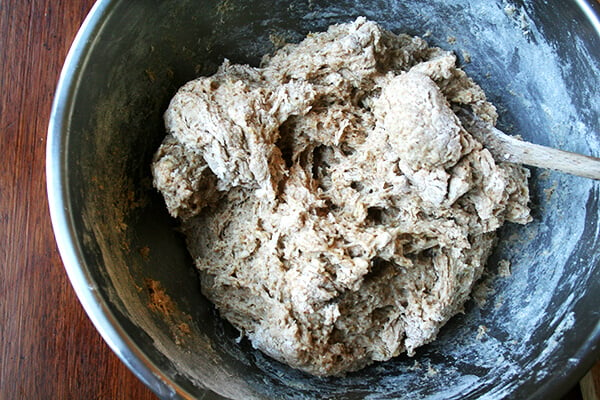

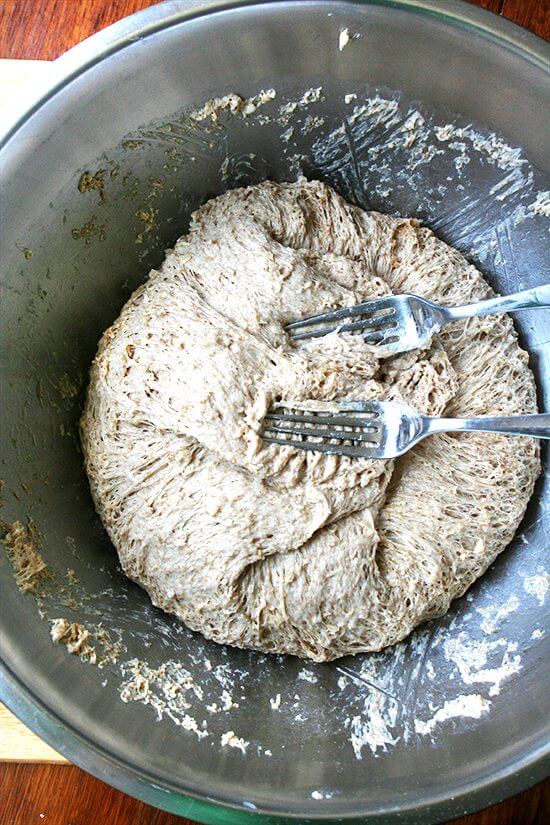
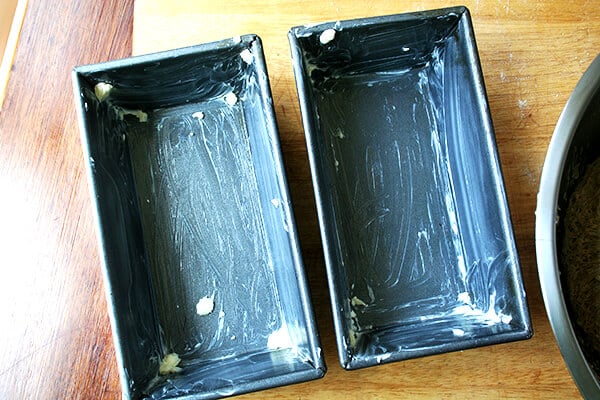

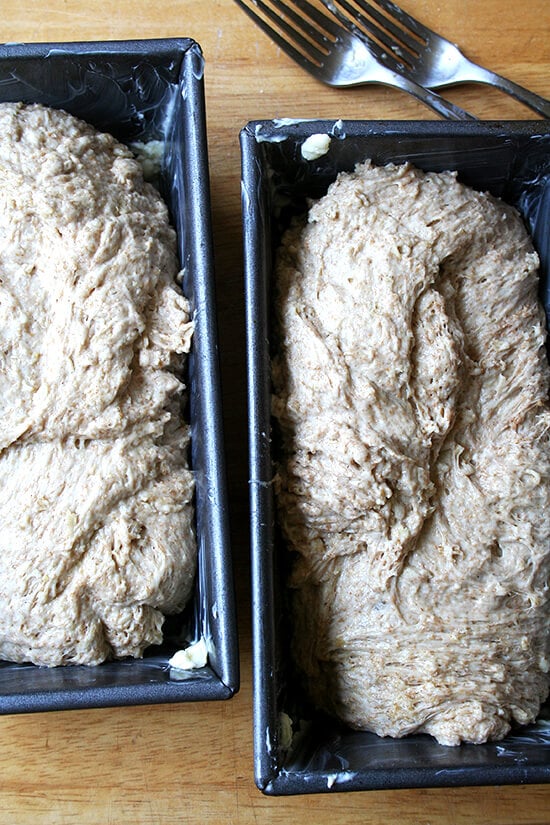
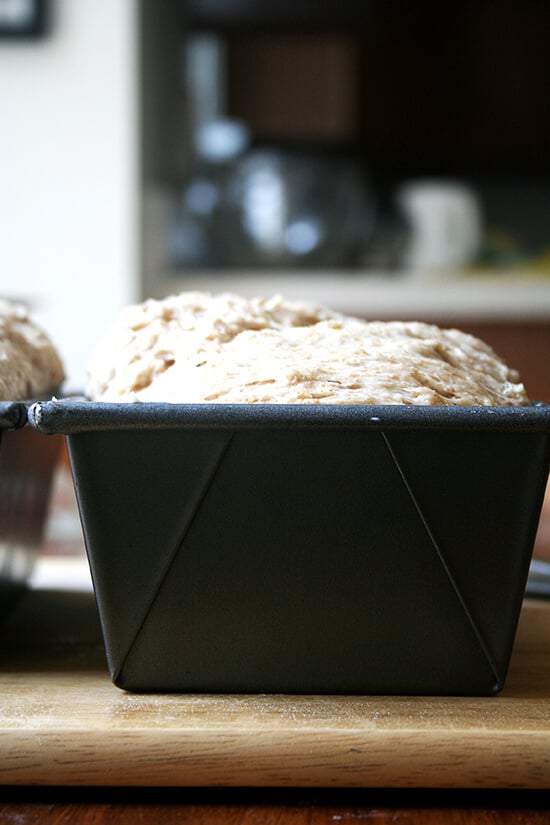
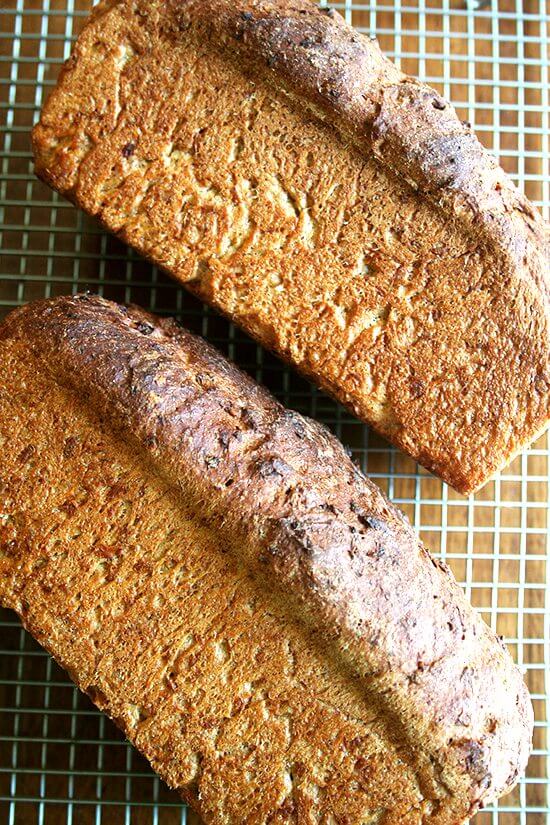


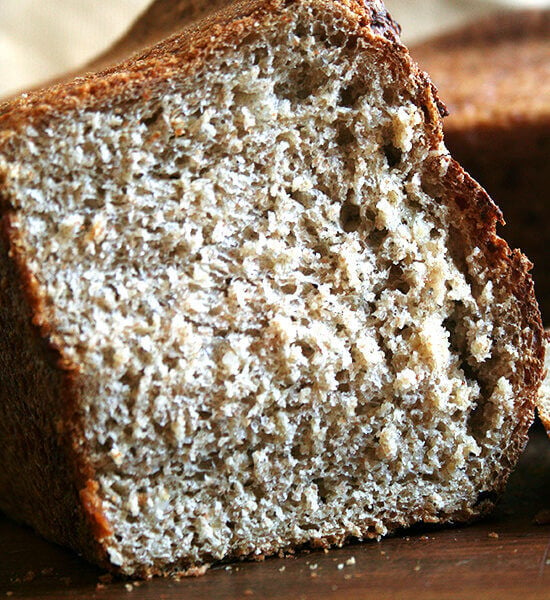
No-Knead Oatmeal Bread
- Total Time: 3 hours 20 minutes
- Yield: 2 loaves
Description
Adapted from Kathleen’s Bake Shop Cookbook
Ingredients
- 3/4 cup (160 g) brown sugar
- 1 tablespoon kosher salt
- 1 3/4 (175 g) cups old-fashioned oats
- 3 cups (681 g) boiling water
- 2 tablespoons (28 g) butter
- 2.25 teaspoons active dry or instant yeast
- 1/4 cup (57 g) warm water
- 3 cups (384 g) all-purpose flour
- 3 cups (384 g) whole wheat flour
Instructions
- Place brown sugar, salt and oats in a large mixing bowl. Add boiling water. Add butter. Let stand till lukewarm. Note: This is the only place where you could mess up the recipe. The mixture must cool to a lukewarm temperature so that it doesn’t kill the yeast.
- In a small bowl, sprinkle yeast over the 1/4 cup warm water. Let stand for about 5 minutes. Stir. Add this yeast mixture to the oat mixture and stir. (Note: If using instant yeast, simply whisk it into the two flours in a large bowl. Do still be sure to wait until the water-oatmeal-brown sugar mixture has cooled before adding the flours/yeast. Add the 1/4 cup water to the bowl of water-oatmeal-brown sugar.)
- Add the flours a little bit at a time. My old recipe says to add it one cup at a time, but I’m never that patient. Add it as slowly as you can tolerate, stirring to combine after each addition.
- Transfer dough to a lightly greased bowl and cover with a damp tea towel or plastic wrap. Let rise in a warm spot until doubled in bulk, about 2 hours. This is what I always do for my “warm spot”: preheat the oven to its hottest setting for 1 minute. TURN OFF THE OVEN. (Note: Only preheat the oven for 1 minute total — in other words, don’t wait for your oven to heat up to 500ºF and to sit at that temperature for 1 minute. You just want to create a slightly warm spot for your bread to rise.) Place covered bowl in the oven to rise until doubled.
- Grease two standard sized loaf pans generously with butter. When dough has risen, punch it down. I use two forks to do this. I stab the dough in the center first, then pull the dough from the sides of the bowl towards the center up onto itself. Then I take my two forks and, working from the center out, I divide it into two equal portions. Place each portion into your prepared loaf pans. Let rise until dough creeps above the rim of the loaf pan.
- Preheat the oven to 425ºF. Bake loaves for 10 min. Reduce heat to 350ºF. Bake for another 40 to 45 more minutes or until the bottom of the loaf sounds hollow when tapped — you have to (obviously) remove the loaf from the pan to test this. Turn loaves out into wire racks immediately to cool.
- Prep Time: 20 minutes
- Cook Time: 50 minutes
We had a wonderful time on vacation. We stopped in Williamsburg on the way to Virginia Beach (obviously to give Ella and Graham a little history lesson); we stayed in awesome cabins; we bought as-fresh-as-fresh-can-be fish (rockfish and sea bass) every night from Dockside, which we grilled whole and devoured; and we spent hour upon hour at the beach.

This post may contain affiliate links. Please read my disclosure policy.












213 Comments on “No-Knead Oatmeal Toasting Bread”
Can this be made without the sugar?
Yes! The texture will change considerably, but it can be done.
Did not have wholewheat flour so i use half cup chia and half cup flax seed meal. The dough did not rise as much for the first rise. It rise at the rim of the baking pan for second rise, baked for 40 mins. Bread was soft and nice but did not have the height. Can i increase the amount of yeast to 1 tbsp. Thanks
This has become my go to Corona virus shelter in place recipe. I use directions and quantities for instant yeast and 1 quart bowls. Today I was out of oatmeal (my husband has been ” just nibbling” homemade granola at an astonishing rate) so I substituted Wheatena cereal, soaked and sweetened as in the recipe. I needed more water, almost one cup of room temperature water additional, and it took about 5 minutes longer to bake. But it worked! I think I have lost my fear of yeast.
Oh Mira! So wonderful to hear all of this 🍞🍞🍞 This made me laugh: “my husband has been “just nibbling” homemade granola at an astonishing rate” 😂😂😂
I made Peasant Bread for the first time and I am very pleased. It is now my “go to” bread recipe. I followed your instructions exactly, I even purchased a digital scale for weighing flour and ordered SAF instant yeast from Amazon. Now to try Oatmeal Bread. I want to use my digital scale so how many grams is the 6 cups of flour? Also, when using instant yeast, when should I add it? How much time for the second rise? If I want to refrigerate half of the dough for later, do I let it rise once first? How long can the dough be kept in refrigerator? Then when I am ready to bake it, do I leave it to rise back in the warmed oven?
Hi Diane! I just updated the recipe to include weights … have been meaning to do this for a long time so thanks for the nudge. Questions answered below:
Also, when using instant yeast, when should I add it? I made a note in the recipe.
How much time for the second rise? Rely on visual cues here: Let the dough rise until it creeps above the rim of the loaf pan (could be 20-45 minutes).
If I want to refrigerate half of the dough for later, do I let it rise once first? Yes, let the whole batch of dough rise. Deflate it, transfer one half to the prepared loaf pan. Transfer the other half to a bowl or an airtight container and transfer to fridge. I would coat the dough lightly with oil to prevent it from drying out in the fridge.
How long can the dough be kept in refrigerator? I’ve left dough in the fridge 24-48 hours.
Then when I am ready to bake it, do I leave it to rise back in the warmed oven? I would transfer the cold dough to the buttered loaf pan, and then either let it rise at room temperature or in the warmed oven. If you let it rise in the warm oven, be sure to remove it before you preheat the oven 🙂
Thank-you for the quick response to my questions.
I will make Oatmeal Bread as soon as grocer has Whole Wheat Flour back in stock. I have enjoyed reading your recipes and learning new methods from your instructions.
So nice to hear this, Diane 💕💕💕
I made the oatmeal bread yesterday, and while I really like the flavor, I didn’t get a proper rise. I went off to do another project while the oatmeal mixture was cooling, and by the time I got back to it it was at room temp, not lukewarm. Was that my problem? It also seems like a small amount of yeast for such a large amount of flour.
Hmm, hard to say. I don’t think it being room temp is an issue. If you are willing to give it another go, you could definitely try using a tablespoon of yeast or simply increasing the first rise. How long was the first rise?
About 2 ¼ hours
OK, that sounds about right. I think the next step would be to increase the yeast, and you could then see how it looks at 2.25 hours … you can increase this to 3 hours if it still isn’t doubled. Let me know if you give this another go. Sorry for the trouble with this one!
Well this looks fabulous… but so does the oatmeal-maple bread in your book (which is constantly on my kitchen counter.) Do you have a preference between the two?
Hi Carol! Thank you 😍 So nice to hear this. My preference is the one in my book. This is an old favorite, but it’s a touch sweet for my tastes these days. That said, I used to absolutely love it, and everyone I’ve made it for loved it too. If you’re looking to make a loaf (as opposed to a bowl), and if you’re looking for a recipe that yields a larger quantity of bread, this is a great option. Also: I think you could definitely cut the sugar back without adversely affecting the flavor.
I made the oatmeal maple bread today, the one from the book. It was outstanding!! Do you think when I make it again I can put oatmeal in the bowl like we do with the “everything seasoning“ for the peasant bread?
Oh yay! Wonderful to hear this, Carol. And yes, absolutely re oatmeal in the buttered bowl 😍
Would love to try this with sourdough starter, without yeast. Do you have a recipe for that? Thanks
Hi Angie! I don’t, but I would suggest starting with 100 g or 125 g starter. I typically use 100 g starter for every 4 cups (512 g) flour.
Okay wow. This bread turned out way better than I expected. The no knead brioche recipe of yours is my go to, but a recent stint at being vegetarian made me chance upon this recipe in this blog (omitting eggs but not crusty bread).
I was sceptical about the no knead with the rising time being only 2 hours and a visibly less wet dough than all the other no knead recipes you have posted till now.
I am glad I was wrong. This came out soft, a bit sweeter than my taste but absolutely delicious. A hit with my entire family.
Thank you for your great recipes.
P.S.: I used instant oats because it is what we have and the bread still came out beautifully.
Wonderful to hear this, Aashna! And I’m with you: this is a little sweet for my tastes these days, but I think the bread would be just as good if you cut the sugar way back. Thanks for writing!
Hello will it work if I swap the whole wheat flour with ALL unbleached AP?
Thank you!
Yes, go for it!
This bread has been my go-to breakfast for about a year now (two thick slices buttered). It is hearty and is like eating a bowl of oatmeal but in a much more convenient form. My office has a toaster over and a toaster so I just take a loaf each week and my office mates are all jealous because the aroma fills the office suite when toasting. I am so thankful to find this website. It has been my salvation when it comes to bread making.
So wonderful to hear this, Kathryn! Thanks so much for writing. This is one of my favorites as well 🍞🍞🍞🍞🍞
I love the flavour of this bread, but I did cut back on the sugar. I used 1/4 cup each of brown sugar and molasses. The problem I had was the dough was dry and I had to knead to mix it. I was expecting a wetter dough for no knead. The second time I made it I did not knead as long and did not get a good rise. I am thinking next time I will use a scale. Should the dough be quite wet?
Hi Donna! I think a scale will make all the difference. And yes, the dough should be on the wet side.
I love your recipes, Alexandra, both bread and non-bread. I’m away from my trusty copy of BREAD TOAST CRUMBS, and so I looked up this oatmeal bread recipe here and decided to give it a go. I thought I had my loaf pans, and the recipe was already well underway when I realized that I didn’t. Then I remembered that your loaf pan recipes tend to be 1.5 times the size of the bowl recipes, so I thought…well, I can figure this out. I saw your helpful note about being able to refrigerate some of the dough after the first rise, and figured, okay, well I refrigerate a third of it. All good, except then I misread the recipe and added less than a third of the water that I should have to the oats. I only figured this out when after adding the flour in small portions, the whole thing looked like a ragged mess. I kept looking at the recipe thinking, how could this be? Alexandra has never steered me wrong before! Then I saw…oh: THREE cups of boiling water. This was after I’d already combined everything, so I started adding warmish water by guess and by gosh to make up for the amount that I’d left out, and ended up with a mushy mess. Still, I put it in a bowl in the warmed oven and crossed my fingers. Two hours later, wouldn’t you know it looked like dough! Then I kind of sort of guessed and divided the dough and put in the buttered bowls the amount I remembered from having made your other recipes, using the digital scale to back me up. Then I did the second rise, and then I baked them, guessing at the temperatures because who knew WHAT was going to happen now. And Alexandra, the bread was great. The moral of this story is that your recipes are indestructible, even by me. Thank you!
Oh my goodness, this was an adventure to read!! 🙂 🙂 🙂 Love it so much, and I am just so, so happy to hear the bread turned out well in the end. There is nothing more disappointing than going through a serious effort and a mess of ingredients only for things not to work out as planned.
Thank you so, so much for writing! Happy Happy Baking.
This was a fun read. 😁
Could you add raisins to this? Or would that add to much moisture or affect the texture?
Absolutely! Not too much moisture at all. I add raisins right to the dry ingredients — toss them with the flour; then proceed with the recipe.
Any reason I should not use bread flour instead of regular flour?
Thanks.
Nope! Go for it!
Can i use flax seed meal and chia seeds to replace some of the wholewheat flour. Do i need to add more water thanks.
Hi! I’m not sure how to advise here as I’ve never tried doing this. Keep in mind the flax meal and chia will not have any gluten, so if you replace the flour with them, the dough may not have enough strength to rise … it could lead to a denser crumb. Regarding the water, you’ll have to see … it’s hard to know without knowing the proportions. I would reference the photos of the dough, and if it looks dryer than the photos, add a little more water until you get it to the right consistency.
Did not have wholewheat flour so i use half cup chia and half cup flax seed meal. The dough did not rise as much for the first rise. It rise at the rim of the baking pan for second rise, baked for 40 mins. Bread was soft and nice but did not have the height. Can i increase the amount of yeast to 1 tbsp. Thanks
Sure, you can increase the amount of yeast, but you’re likely not getting the height because of the high amount of chia and flax seed meal … there’s no gluten in those two items, so the dough won’t have the strength — it won’t be able to form a strong gluten structure to trap air pockets and to rise.
Hi there – can I substitute steel cut oats for the old fashioned oats? Also, recipe is just lovely but a touch too sweet for me. How much can I safely reduce the sugar? Thanks so much!
Hi Karo! You can safely cut back the sugar as much as you wish — most often these days I make bread without any sugar, so just cut back as much as you feel is good for your tastes.
Regarding steel cut oats, I think you can, but I have never tried, so I can’t totally advise, but I don’t see why it wouldn’t work.
Just made this yesterday and it was a winner. The only thing I will change is to cut back on the sugar as it is a bit too sweet for my taste. I want to thank you for your wonderful bread recipes that have kept me going in these Covid times. There’s always something new to try every week and they all work and are so easy! I have recommended your blog to all of my friends.
Hi Heather! Great to hear this. And I totally can understand cutting back the sugar. I almost never add sugar to my bread recipes these days, so I think this one will turn out beautifully with the sugar cut back. Thank you for your kind words! Means a lot 🙂 🙂 🙂
Love this recipe! Made one loaf regular and one with a cinnamon-sugar swirl and some mini chocolate chips and both turned out great. Is it possible to adjust this for a 9×5 loaf pan?
I think each would take 2 cups extra dough than the standard size pan, but how should the baking time/temperature change? Has anyone experimented with this?
Hi Sarah! Are you using an 8.5 x 4.5-inch loaf pan now? Part of me thinks you wouldn’t have to adjust the recipe at all for a 9×5-inch pan, but you could try doing 1.5x the recipe for a larger pan.
Okay to use vegan butter to make this a vegan bread? Thank you for all you share – I made your pitas today and they are amazing!
Absolutely! And thank you 🙂 Means a lot.
Wow, this was delicious and taste just like my favorite bread Milton’s Multigrain, except I know what’s in it and that there are no preservatives. I may never buy bread again, it was so easy!
Great to hear this, Kate! Thanks so much for writing 🙂 🙂 🙂
Ali,
Great recipe! I’m new to bread making. Should I cover the loaves with a damp tea towel again on the second rise? Also, I’ve seen people brush the top with butter/oil before baking. Do you recommend this, and what effect would it have? Thanks!
Jessica
Hi Jessica! No need to cover bread on the second rise. I would caution against brushing with butter and oil before baking because it might burn. If you want a glossy look on top, brush during the last 10 minutes of baking.
Great! Thank you–this bread came out absolutely delicious–was a huge hit with my husband and son. Hearty and filling as well as healthy and versatile. I made your pita bread, and the way you lay out the directions makes it so easy, I decided to the oatmeal as well. I am VERY new to baking bread, and your recipes have allowed me to be successful and enjoy it. One more question: can you substitute maple syrup for the brown sugar in the oatmeal bread?
Thanks again–you’ve made me a “bread-winner” 😉
Jessica
💕💕💕💕💕💕 BREAD WINNER: Love this so much 🙂
Yes, absolutely use maple syrup in place of brown sugar. Yum.
So nice to hear all of this.
I spoke with you several times about the recipes and I was asking for a brown bread recipe and I had to go look up what you were talking about and can I have never heard of that-
I’m still searching and a little afraid to try to with that by using the lasses and honey and rye and some of the things called for in the brown bread recipe..
I’m still hoping you can come up with something that would achieve a nice sweet brown bread I’m going to try it with this wish me luck…
Hi Janice! I hope this one turns out well! I also just remembered I have this honey whole wheat bread on my site that used to be my go-to bread recipe. It’s from the bakery lane cookbook: https://alexandracooks.com/2011/10/05/when-people-come-to-visit/ It’s so yummy.
You might look on-line for Cheesecake Factory Brown Bread recipes; there are a few. I made this one yesterday & it was GREAT!!! [https://www.youtube.com/watch?v=yOXDDMPq4rs] My husband has commented & thanked me twice now and it’s only one day ago! He-he. Hope this helps.
Aloha,
Sue
Thank you!! I get asked about brown bread recipes all the time … now I have a place to point people to. It looks wonderful!
Yummy yummy it -is so vey good and easy😋 I make at least one or two of your recipes every week I am working on that brown bread recipe if you come up with one that doesn’t require a lot of work let me know but again it is not that brown bread that you see in a can-
Some of the recipes I have looked at have rye flour but most of them all have one thing in common molasses coffee and cocoa 🧐
Ok, great to hear this, Janice! I’ll keep trying, but given your comment about molasses and coffee, I think this one is promising! Maybe if I replaced some of the flour with cocoa: Salted Oatmeal Cookies & More
This bread has been my go-to breakfast for about 2 years now. I always keep some on hand. It is easy to make and delicious. I am so glad I found this food blog and the recipe for this bread. I have experienced some variability in the loft (sometimes the bread doesn’t rise very much) but that is probably due to kitchen conditions ad my own bad timing with the second rise.
So nice to hear this, Kathryn! This is one of the first bread recipes I learned to make and it continues to be a favorite. Regarding the second rise, weather/humidity/temperature/timing do all play a role. I always shoot for the dough crowning the rim of the pan — so it’s still on the up and up when it enters the oven.
Hi, Thank you for this recipe! Could I use the King Arthur sprouted wheat flour in the place of the whole wheat flour for this recipe? Also could I use the Pyrex bowls used for your Peasant Bread recipe? I bought 4 bowls after you recommended them for your Peasant Bread…but no loaf pans! (I also have 2 of the next size up Pyrex bowls if this recipe yields too much for the smaller bowls.) Thank you for any advice! ps. I am a new bread maker and your Peasant Bread is the first and only bread I’ve made. After finding your recipe, I can’t imagine a better tasting and easier bread to make. I can’t stop making it and my family loves it! I’ve finally come back to find another recipe with whole grains.
Hi Patricia! Questions answered below!
Could I use the King Arthur sprouted wheat flour in the place of the whole wheat flour for this recipe?
Yes!
Also could I use the Pyrex bowls used for your Peasant Bread recipe?
Yes! Just be sure to not overfill the bowls … the bowls should be about 3/4 full.
I bought 4 bowls after you recommended them for your Peasant Bread…but no loaf pans! (I also have 2 of the next size up Pyrex bowls if this recipe yields too much for the smaller bowls.)
If by the next size up you mean 1.5-qt bowls, I think that actually is a better size, but again, the key is just to not overfill the bowls so that the bread bakes evenly/properly.
Thank you for any advice! ps. I am a new bread maker and your Peasant Bread is the first and only bread I’ve made. After finding your recipe, I can’t imagine a better tasting and easier bread to make. I can’t stop making it and my family loves it! I’ve finally come back to find another recipe with whole grains.
So nice to hear all of this!! Thanks so much for writing. Let me know if there is anything else 🙂
Thank you! I’ll try this recipe in my two 1.5 quart round Pyrex bowls. Would I change the baking temperature and time when using these bowls instead of the loaf pans?
I’m using the KAF sprouted wheat, and also sprouted oats . I’ll let you know how it turns out!
Hi Patricia! I don’t think you’ll need to change either the baking time or temp when using the 1.5 qt bowls. Good luck!
Hi Alexandra
You say to use standard bread pans – do you mean 8×4 or 9×5 ?
Thanks
Nancy
Great question … “standard” is so vague! I suppose I would say 8.5 x 4.5, so if you have either of the pans you mentioned on hand, I would go with the larger pan.
I made this bread. The dough did not come together easily, was sort of on dry side. Maybe i added too much flour? I weighed the flour on a scale. My loaves were dense and hardly any crumb. Guess I’ll have to try again.. any advice?
OH darn! So strange because this is a very high hydration dough… did you weigh the water? The total water weight would be 681+75=756 gram and if you divide this by the total flour weight 768 grams it’s 0.98 or 98%. My only advice would be to carefully measure everything, and if the dough seems too dry, add more water until you have a wet, sticky dough.
Hi! I am loving your recipes and have made this one four times. I’ve played a little bit with reducing the sugar and salt, reducing just the salt, following it exactly or adding seeds but each time I can’t seem to get the dough to creep over the top of the pan. I’ve also experimented with adding the instant yeast to the flour or letting it saturate. The dough seems to rise well for the first proof and fills 3/4 of the pan when split. How long does the second proof usually take? Do you cover it with anything? Thanks for your help! And thanks for your lovely recipes.
Hi Lindsey! I have to admit I haven’t made this one in a while, but I’ve been meaning to revisit it on the same thinking, reducing the sugar in particular. Questions: are you using a scale to measure? Does the dough seem stiff? Part of me wonders if you might need to reduce the amount of flour slightly. Also, the second proof can take a very long time (over an hour), especially in winter months and if your kitchen is cold. I typically don’t cover it but if the dough looks as though it’s drying out, you can cover it with plastic wrap. Produce bags from the grocery store are also good. You can stick the whole pan in the bag and tie a knot.
Yes I use a skill to measure and the dough is very stiff. I am not able to fully incorporate the flour and water with a spoon only and have to use my hands. I currently have a batch going now so maybe I will add a little more warm water to it and see if that helps. These second rises sometimes taking 2 hours or more even in a warm environment and it still doesn’t creep over the top. It still tastes delicious but I’m thinking we could get it a little bit more poofy. 🙂 Thanks for replying!
OK, great to hear about the scale! Next time, I might consider holding back some of the flour. I really need to revisit this recipe. Will post an update as soon as I do.
Hi Ali,
Apologies for posting this here but I wasn’t sure how else to ask you this question: I’d like to make both the cinnamon swirl bread and the oatmeal maple bread from your book for my family on vacation next week. Is it possible to refrigerate the dough overnight once it’s in the loaf pans and then bake off in the morning? If so, should I bake straight from the fridge or would it be best to let them return to room temperature first (30 or 60 mins)?
Many thanks – I know my in-laws will love your breads!
Hi Vicki! This is a fine place to post your questions 🙂
Yes, you definitely can. Here are a few things to consider: sometimes, especially in the summer, dough rises very quickly even in the fridge. I worry about your cinnamon swirl bread in particular spilling out of the pan in the fridge, because that is not a dough you could simply deflate again, re-shape, and return to its pan. Whereas with the oatmeal maple bread, if it rises too much, you could simply deflate it, and let it rise again.
What size are the loaf pans you are planning on using? If you are using 9×5- or 10×5-inch pans, the dough should be fine.
My suggestion would be this: as soon as you shape the cinnamon swirl loaves and get them in their pans, transfer them to the fridge immediately, and I would tuck them in a large ziplock bag or cover the top with plastic wrap to ensure the dough does not dry out. Place in the coldest part of your fridge.
In terms of baking, if you remove the pans from the fridge, and the dough has risen sufficiently as in it is crowning the rims of the pan, you can bake straight from the fridge or let them rise at room temp while the oven preheats.
Let me know if this all makes sense!
Brilliant – thanks Ali! I will give it a go and keep my fingers crossed they don’t spill over… I’m going to be using 8.5×4.5 inch pans unfortunately, so on the smaller size, but I’ll try with the oatmeal maple bread first and see how it goes before I attempt the cinnamon swirl.
That’s a smart idea! Good luck!